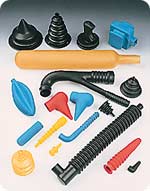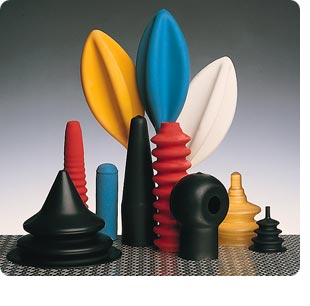
Chloroprene or natural rubber and other synthetic latices such as
Nitrile are particularly suitable for the production of very complex
shapes in small and medium quantities, although larger volumes can
be produced. However the techniques and materials are more expensive
than PVC dip moulding and consequently, the processes should only
be considered when the particular properties of Chloroprene or Natural
Rubber are required.
Properties
Chloroprene dip mouldings, tested against BS 903, show the following
properties. Normal BS softness is 100 and wall thicknesses can be
between 0.1mm and 2mm.
|
|


Low cost Latex Dip Moulding is the answer for producing complex
shapes which are expensive if made by any other process.

Since 1995 we are certified by ISO 9002.
|
 Comparison
with plasticised PVC Comparison
with plasticised PVC
The elastic characteristic of Chloroprene is one of the main differences
when compared with PVC and this is important where, for instance,
a product has to be considerably stretched during fitting. The high
elongation at break and low modulus are also beneficial in such
an application.
The permanent set of Chloroprene is lower than PVC and this is important
where, for example, the elasticity of the moulding is required to
secure it to another component.
Chloroprene has generally higher solvent resistance than PVC, particularly
to aliphatic hydrocarbons such as petrol. It can also be used at
higher temperatures and in the range -40°C to +100°C shows
less variation in properties. Prolonged exposure to high temperatures,
however, would result in ageing problems.
Most mouldings are matt black, colours are available if required.
It is not possible to produce gloss finishes or semi-rigid mouldings.
Comparison with natural rubber
The properties of mouldings made from the two materials are similar,
although Chloroprene has better ageing and weathering characteristics
with high resistance to ozone cracking, uv irradiation and oxidation.
|





